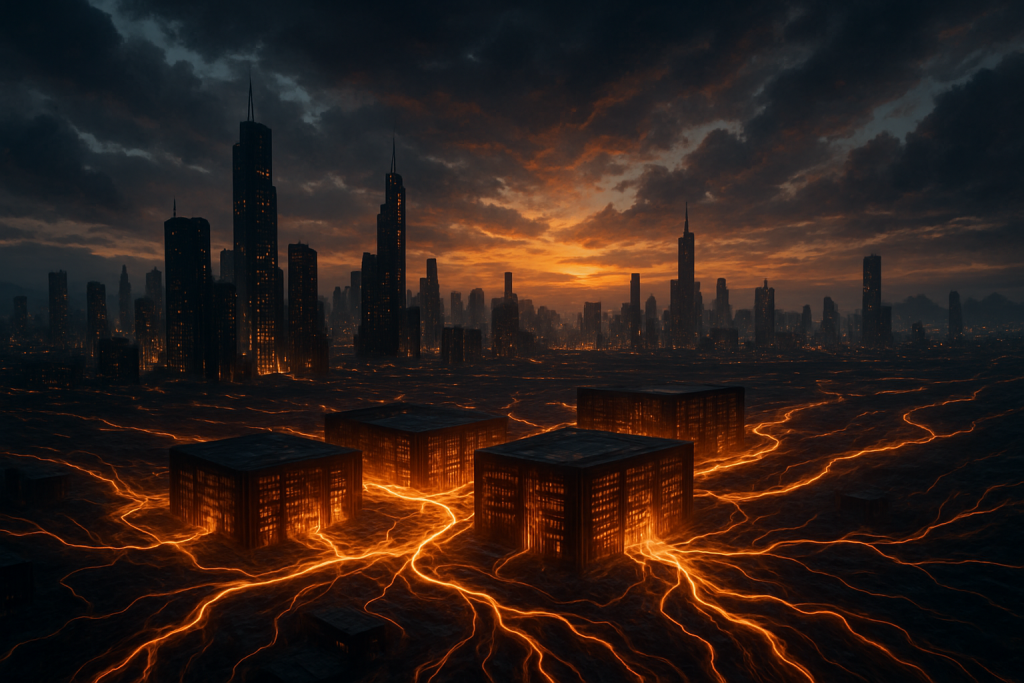The year is 2025, and the AI arms race is in full swing. Forget dial-up modems and waiting hours for a blurry picture to load; we’re talking about algorithms so complex they make Deep Blue look like a Speak & Spell. And just like the space race of the 20th century, this one has a clear geopolitical dimension: the US versus China. Yesterday, the Trump administration fired a shot heard ’round the silicon world, unveiling a series of executive actions designed to supercharge America’s AI ambitions.
At the heart of this initiative lies a simple, yet often overlooked, truth: AI needs power. Lots and lots of it. We’re not just talking about charging your phone overnight. We’re talking about the kind of energy consumption that could make a small country blush. Industry analysts are predicting a thirtyfold increase in power demand from AI data centers by 2035. Think about that for a second. That’s like going from a single lightbulb to illuminating the entire Las Vegas strip, times thirty. The administration clearly understands this, and their response is bold, ambitious, and, well, characteristically Trumpian.
The plan has three key pillars: easing the gridlock for new power projects, opening up federal lands for data center construction, and streamlining the regulatory nightmare that often accompanies large-scale infrastructure projects. Let’s break down each of these, shall we?
First up, the power grid. Imagine trying to merge onto a six-lane highway during rush hour, but instead of cars, you’re trying to connect a massive new power plant. That’s essentially the challenge the administration is trying to address. By streamlining the process for power-generating projects to plug into the electrical grid, they hope to accelerate the integration of new energy sources, ensuring that AI data centers have the juice they need to operate at full throttle. Think of it as giving the AI industry a massive, government-sponsored caffeine injection.
Next, we have the land grab. Uncle Sam owns a lot of land, and the administration is now offering some of it up for the construction of AI data centers. Specifically, land managed by the Department of Defense and the Department of the Interior is on the table. This is a big deal because finding suitable locations for these massive facilities can be a major headache. Zoning regulations, environmental concerns, and NIMBYism (Not In My Backyard) can all throw a wrench in the works. By offering federal land, the administration is essentially saying, “We’re cutting through the red tape and paving the way for AI dominance.” It’s like a real-world version of SimCity, but instead of building a virtual metropolis, you’re building the infrastructure for the future of artificial intelligence.
Finally, the regulatory reform. Ah, bureaucracy. The bane of every entrepreneur’s existence. Currently, data centers need to obtain permits from each individual state, a process that can be slow, costly, and unpredictable. The administration is proposing a nationwide Clean Water Act permit, which would replace the current state-by-state system, reducing bureaucratic hurdles and accelerating project timelines. This is akin to swapping out a horse-drawn carriage for a Tesla Model S when you are trying to win the Indy 500. It’s about speed, efficiency, and getting things done.
The administration has also ordered the production of an AI Action Plan, due by July 23, 2025, with the potential designation of that date as “AI Action Day” to draw public attention to these efforts. One can almost picture the press conferences, the banners, and maybe even a celebratory AI-generated fireworks display. It’s all part of a broader strategy to make America the undisputed king of the AI hill.
But what does all this mean in the grand scheme of things? Who are the winners and losers? And what are the potential pitfalls?
The obvious winners are the tech giants like OpenAI, SoftBank, and Oracle, who are already heavily invested in AI infrastructure. The administration’s policies will make it easier and cheaper for them to build and operate their data centers, giving them a significant competitive advantage. Remember the Stargate Project, the multi-billion-dollar initiative to build data centers and create over 100,000 jobs? This new policy is rocket fuel for efforts like that.
However, there are potential downsides. Streamlining environmental regulations could lead to unintended consequences, potentially harming ecosystems and local communities. And the concentration of AI infrastructure in certain areas could exacerbate existing inequalities, creating “AI haves” and “AI have-nots.” The environmental impact, especially regarding water usage and carbon emissions, is a serious concern that needs to be carefully addressed. Building massive data centers requires a lot of water for cooling, and powering them with fossil fuels could undermine efforts to combat climate change. It’s a delicate balancing act between technological progress and environmental responsibility.
Then there’s the geopolitical angle. This isn’t just about technological innovation; it’s about global power. The US and China are locked in a fierce competition for AI supremacy, and the administration’s policies are clearly designed to give America an edge. But this competition could also lead to increased tensions and even a potential AI arms race, with unforeseen consequences. It’s like a high-stakes game of chess, where the winner takes all, but the loser could end up with nothing.
Finally, there are the ethical considerations. As AI becomes more powerful, it raises profound questions about its role in society. Who controls AI? How do we ensure that it’s used for good? And what happens when AI becomes smarter than us? These are questions that we need to grapple with now, before it’s too late. The AI revolution is already here. The Trump administration’s actions are just the latest chapter in a story that is still being written. Whether it’s a dystopian nightmare or a utopian dream remains to be seen. But one thing is certain: the future of AI is in our hands, and we need to choose wisely.
Discover more from Just Buzz
Subscribe to get the latest posts sent to your email.


